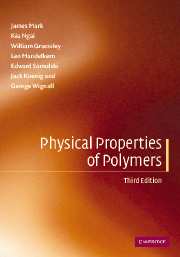Book contents
- Frontmatter
- Contents
- Notes on contributors
- Preface
- Part I Physical states of polymers
- 1 The rubber elastic state
- 2 The glass transition and the glassy state
- 3 Viscoelasticity and flow in polymeric liquids
- 4 The crystalline state
- 5 The mesomorphic state
- Part II Some characterization techniques
- Index
- References
2 - The glass transition and the glassy state
Published online by Cambridge University Press: 05 June 2012
- Frontmatter
- Contents
- Notes on contributors
- Preface
- Part I Physical states of polymers
- 1 The rubber elastic state
- 2 The glass transition and the glassy state
- 3 Viscoelasticity and flow in polymeric liquids
- 4 The crystalline state
- 5 The mesomorphic state
- Part II Some characterization techniques
- Index
- References
Summary
Introduction
The glass transition in noncrystalline polymers under ordinary experimental conditions occurs on cooling when the characteristic time of molecular motions responsible for structural rearrangements becomes longer than the timescale of the experiment. As a result, structural relaxation toward equilibrium is arrested below some temperature, Tg, and the polymer is in the glassy state. The molecular motions responsible for structural relaxation in polymers involve only a small number of repeat units of each chain, and it is appropriate to refer to them henceforth as local segmental motions. In polymers, molecular motions involving more repeat units of each chain are possible and they contribute to viscoelastic properties over broad ranges. The molecular motions of longer range have characteristic times longer than the local segmental motions, and therefore a necessary condition for the former to contribute to observable viscoelastic properties of the polymer is mobility of the latter, which means that the temperature has to be higher than the glass-transition temperature, Tg. Thus, the glass transition is perhaps the most important factor that determines at any temperature and pressure the viscoelastic properties and applications of noncrystalline polymers. For example, if Tg is much higher than the temperature of application, the polymer is a hard glass and may be suitable for applications as engineering plastics. If Tg is sufficiently lower, the polymer is rubbery and may be used in the rubber industry. Many polymers have no crystalline solid state because there are stereochemical variations along their molecular chain-like backbones.
Information
- Type
- Chapter
- Information
- Physical Properties of Polymers , pp. 72 - 152Publisher: Cambridge University PressPrint publication year: 2004
References
Accessibility standard: Unknown
Why this information is here
This section outlines the accessibility features of this content - including support for screen readers, full keyboard navigation and high-contrast display options. This may not be relevant for you.Accessibility Information
- 10
- Cited by
